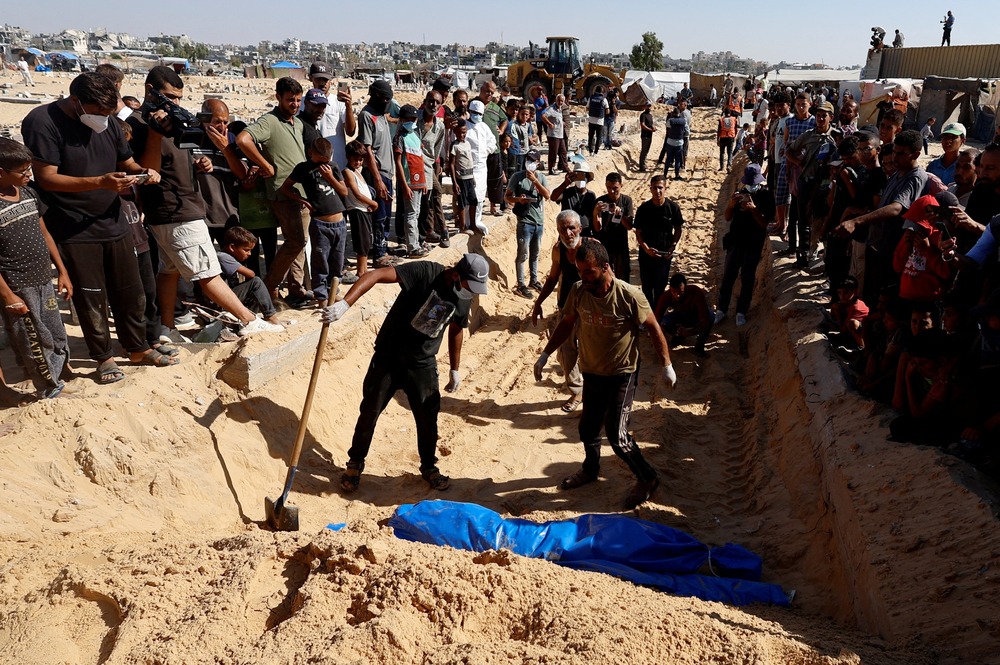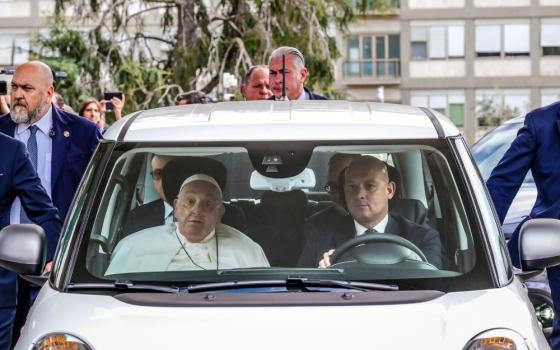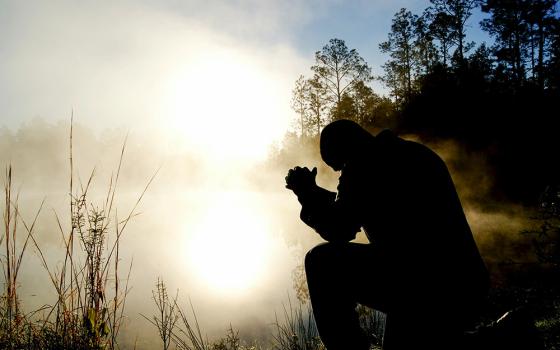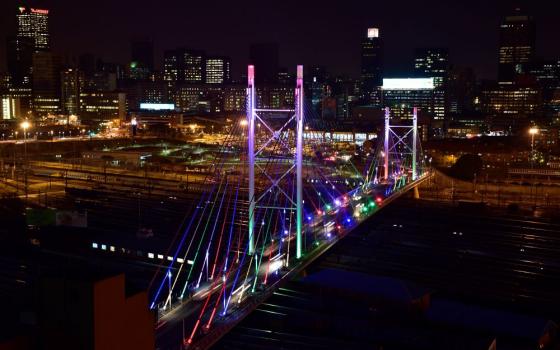
People bury in a mass grave unidentified bodies of Palestinians killed in Israel's military offensive in Khan Younis in the southern Gaza Strip Sept. 26, 2024, after they were handed over by Israel, amid the Israel-Hamas conflict. (OSV News/Mohammed Salem, Reuters)
Even though death surrounds them every day, Gaza Strip's Christian community tries to "relieve the suffering" by assisting each other with spiritual and material needs.
The number of casualties and amount of destruction in Gaza since the outbreak of Israel-Hamas war on Oct. 7, 2023 is so staggering that it is easy to forget that behind all those numbers there is a life, wrote Latin Patriarchate's CEO Sami El-Yousef in a September reflection at the one-year mark of the war approached.
"These statistics include over 41,000 killed including 60% women and children; close to 100,000 injured; a destroyed health and educational systems; over 60% of dwellings and 68% of road networks destroyed; with no infrastructure including electricity, water, sewage, communications; and very limited humanitarian aid trickling in," he wrote.
It is hard to comprehend that now not only the war in Gaza is still ongoing, but that a new front has been added in Lebanon, El-Yousef said, "promising that an already bleeding region is destined to a regional war with more destruction and loss of innocent human life," he wrote.
The Hamas attack on Israeli southern communities left 1,200 people murdered and 250 people taken hostage into Gaza. The military offensive that Israel launched the same day killed over 41,000 Palestinians to-date in the Gaza Strip, according to the enclave's Health Ministry.
The Christian community in Gaza has suffered devastating losses, including the deaths of 17 people after an explosion at the St. Porphyrios Greek Orthodox Church campus in Gaza City, following an Israeli airstrike, toppled the administration building in October 2023.
Two Christians, Nahida Khalil Anton and her daughter, Samar Kamal Anton, were killed in December 2023 as they walked to the convent on the Holy Family Parish's complex.
In April, a 19-year-old woman sheltering in the parish with her mother died from heat stroke as she tried to flee the enclave. Her father had previously died in the Holy Family compound.
In July, a raid launched by Israeli forces against the Latin Patriarchate's Holy Family School in Gaza City killed four people.
"If all the money being spent on weapons was directed to building and development, our region would be in a much better place. The people on the ground are ready for peace, but unfortunately failed leadership on all sides will not allow, at least for now, the wish of the masses for a life characterized by justice, equality, respect, coexistence and freedom for all who call our region home," El-Yousef wrote.
In a phone conversation with OSV News, he said the presence of Father Gabriel Romanelli, who was finally able to join his parish in May, has strengthened the community.
The priest had been outside Gaza on Oct. 7, 2023, and for months was unable to come back. He now tends to the parish along with assistant priest Father Youssef Assad and Peruvian twin sisters of the Institute of the Incarnate Word, Sisters María del Pilar and María del Perpetuo Socorro Llerena Vargas.
El-Yousef said he has seen how the war has taken its toll on Romanelli, who is personally in need of regular monitoring and medicine. There is a lack of much-needed medicine for many in the parish, as in the rest of Gaza, he said.
The patriarchate's CEO said that they estimate that about 45 members of the parish have died since the start of the war — 20 were killed and an additional 25 have died from medical neglect. In addition, the already small Gaza Christian community has shrunk even more so over the past year from 1017 people to 650 people, with many having left when they could.
Advertisement
Still, he said, most who have left still speak about returning to their homes in Gaza once the war has ended and the rebuilding begins.
"I don't think we're concerned that all of (the Christian community) will disappear but I think realistically, we may end up after the war with maybe 50% of the Christian community that existed there," El-Yousef said.
He pointed out that the Christian community in Gaza, which is mainly sheltering on the campuses of the Holy Family Catholic Parish and St. Porphyrios Greek Orthodox Church, is "trying to do their best under extremely difficult conditions to relieve the suffering."
It is done by extending help in terms of remedial education, distribution of supplies, informal activities for the children as well as adults in the form of birthday celebrations, dancing, prayer groups and daily Masses, which help the community release some of the stress and anxiety they are living with constantly.
"In normal circumstances, what is needed in Gaza given the level of trauma would be formal professional psychosocial interventions … . I don't think you can see anyone in Gaza who's not traumatized to the limit, regardless of their age," El-Yousef said. However, he added that the professionals are no longer there. "So the next best thing really is to improvise and do what you can," he said.
Organization of school classes — which are non-existent at the moment throughout Gaza — in the parish is difficult, because the community's Rosary Sisters' school has been structurally damaged by several bombardments and the Latin Patriarchate's school is being used as a refuge for the families.
While most of the Christian community has chosen to remain in northern Gaza in the churches' compounds, almost 86% of the enclave's population — amounting to about 1.9 million people — has been displaced, some multiple times, since the start of the war, said Jason Knapp, country representative for Catholic Relief Services in Jerusalem, West Bank and Gaza.
CRS carries out the work of the U.S. bishops to assist the poor and vulnerable worldwide who live in extreme poverty, war zones or who have suffered natural disasters.
"It's just so massive in terms of the number of people displaced versus those who are still in their homes" that it "continues to impact everything about this (humanitarian) response," he said.
As winter approaches with well over a million people living in makeshift shelters, humanitarian aid organizations are concerned about what will happen when the cold and rain comes, he added.
"We are deeply concerned that there's not enough shelter material, tents, tarps ... to protect people," he said. "Even though last winter was really tough, there was so much more infrastructure still in Gaza and more coping capacities for the population."
He noted that humanitarian aid workers have been killed in the fighting and the conditions for aid delivery are very bad, especially in the areas to which people evacuated.
"Especially in these evacuated areas, it is extremely challenging, and any trucks or vehicles moving through them are often at risk. So it's basically like driving through the front line," he said.
Knapp said in addition to the severe situation of food insecurity there is concern about health and hygiene issues as well as a great need for psychosocial care for all people in Gaza.
The recent distribution and vaccination with polio vaccines made available through the border crossings by Israel was a positive example of what could be possible, he said.





